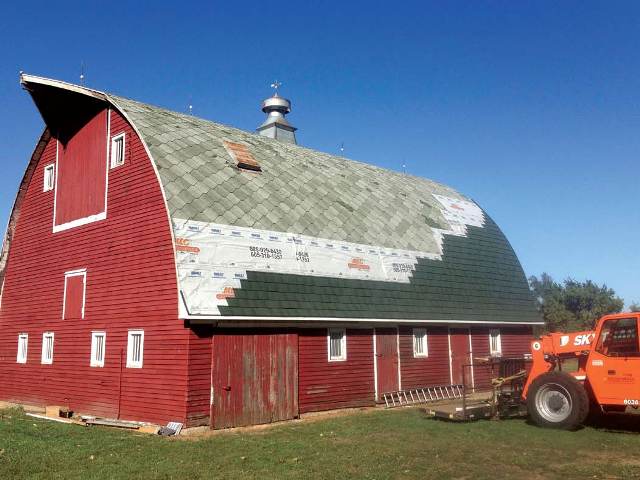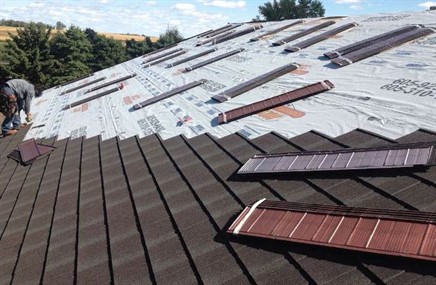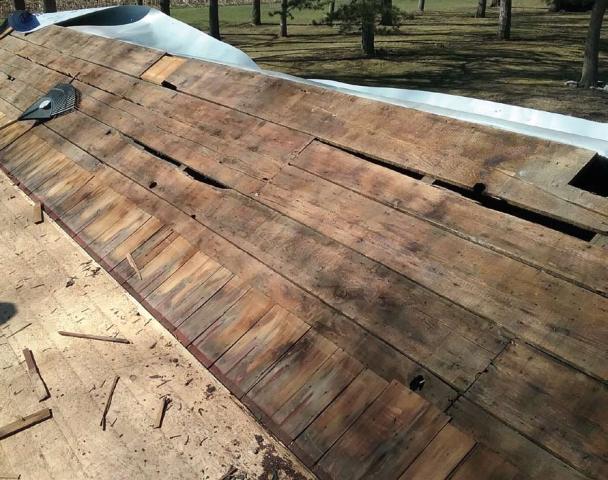Roofing material may be left intact on sloped roofs that meet condition, design and other criteria

Metal roofs are often installed on sloped roofs over roofing material without significant long-term performance reduction. However, for the small number of roofs that fail, mistakes are costly, and, at times, subjects of legal complaints. The avoidance of failures begins at a project’s inception, when owners and contractors discuss roof condition and design, products, installation, budget and other variables. When projects meet certain criteria, roofing over material has the potential to reduce labor and waste disposal costs.

MLC Construction Inc. installed Tri-Built Materials Group LLC’s 50-year synthetic underlayment and Metro Roof Products Inc.’s Metro Shingle in Shadow Wood on a new private residence in DeSmet, S.D. (Photo: Courtesy of MLC Construction Inc.)
Metal roofs are often installed on sloped roofs over roofing material without significant long-term performance reduction. However, for the small number of roofs that fail, mistakes are costly, and, at times, subjects of legal complaints. The avoidance of failures begins at a project’s inception, when owners and contractors discuss roof condition and design, products, installation, budget and other variables. When projects meet certain criteria, roofing over material has the potential to reduce labor and waste disposal costs.
Avoiding Failure
Robert Stanford, president at Robert Stanford Associates Inc., Missouri City, Texas, says there are two types of roof failures: material blow-offs and leaks. Stanford, now retired, worked in the roofing industry for more than 45 years as a contractor, consultant, public speaker and expert witness in roof failure court cases. He says the only way to replace plywood decking is to tear off sections of the material. “[Water damage is] cancer, and you got to get down to it and dig it out and fix it,” he says. “If the existing composition shingles are dried out, cupped up, broken, missing hip and ridge pieces, missing shingles and would interfere because they are totally worn out, you might need to tear it off and ice-and-water shield the whole decking before you put anything down.”
Stanford says for most roofing projects, the quality of the installation determines success and failure. “The biggest single problem in metal roofing is improper installation,” he says. Installing metal tiles or shingles over material on sloped roofs may be reasonable if all the components are in good condition and the installation is executed properly, per manufacturer instructions, he says. “It’s a decorative cover-over that gives you a new roof and a fresh look. And it can be visually satisfying and it may perform. All that depends on how well it’s put together and how well it’s installed.”
Critical Inspecting

Lifetime Shingles LLC removed two layers of asphalt shingles and rotten lumber before installing InterWrap’s Titanium PSU30 ice and water shield, Titanium UDL50 synthetic felt and 3,000 square feet of Metro Roof Products Inc.’s Metro Cottage Shingles in Weathered Timber on a private residence in a township near Forest City, Iowa.
In preparation for installations, contractors examine roofing materials, decking, building structures, attic ventilation and other aspects during inspections to determine whether the conditions and designs correspond with roof-over or tear-off approaches. Marcus Eytcheson, sales professional at Lifetime Shingles LLC, Chili, Wis., has worked in the metal roofing industry for more than 10 years and says the most important part of an inspection is a thorough attic exam. “I think the biggest difference between the guys that are doing a really good job in this and the guys that are not is the guys that are too lazy to get in the attic,” he says. “There’s a lot of guys that don’t want to crawl up there because the hole is too small or they’re going to get dirty, or it’s hot or whatever the excuse is. And that’s probably the most important part of this process. If you don’t go in the attic and look at the back of those roof boards, you really don’t know for sure what you’re working with.”
Eytcheson says when he inspects attics, he checks for balanced intake and exhaust ventilation, insulation and exhaust hoses from kitchens and bathrooms. “Something as simple as [an exhaust hose] can cause condensation and present what appears to be a leak even though it was poor workmanship, and that might have nothing to do with the roofer at all,” he says. “[Attic ventilation balance] has become more and more of a hot topic for us in steel roofing because if things aren’t insulated and vented properly, you’re going to get condensation, it’s going to drip and the homeowner is going to blame you.”
Stanford says he would be concerned about penetrations in roof-over projects utilizing metal tiles and shingles. “How those sections are installed from a waterproofing standpoint would be very critical,” he says. “And I think it’s up to the manufacturer of these products to tell me, show me, teach me and certify me as to how am I supposed to install it, with all of the waterproofing details.”
Limiting Design
The ability to complete interior inspections of the decking and structure can be eliminated if attics are finished. This can lead to a tear-off approach. Adam Parnes is vice president of marketing at Global Home Improvements Inc., Feasterville, Pa., which installs residential roofs in northeast Pennsylvania, New Jersey and Delaware. Parnes says full inspections can be completed for a majority of his company’s projects, and water infiltration is evident. “You can see if there’s rotted wood,” he says. “The homes that you can’t don’t have attic access or it’s a finished attic or it’s a contemporary home. Most of the time in that case we do recommend to just tear it off.”

MLC Construction Inc. installed Tri-Built Materials Group LLC’s 50-year synthetic underlayment and Metro Roof Products Inc.’s Metro Shingle in Sage Green on a private barn in Conan, S.D. (Photo: Courtesy of MLC Construction Inc.)
Multiple layers and snow loads can lead to weight issues and cause tearing off to be more prudent than roofing over. Eytcheson says structural load limits are critical in the region where his company operates in Wisconsin and Minnesota, as large amounts of snow can accumulate on roofs. “So that ends up being a tremendous consideration that you can’t just keep piling the weight on the truss system and expect it to hold it,” he says. “If we get 20 inches of heavy, wet snow, the whole truss system will collapse and be on the living room floor, and we can’t assume that kind of liability.”
It may be more practical to tear off roofing material on roofs with complex designs. Parnes says roofs with numerous valleys, ridge caps and other locations where shingles overlap lend themselves to removing material. “It just changes the landscape of the install,” he says. “The more complex jobs, we’re going to be more safe than sorry and probably do the removal. But on an easy job, on a ranch, there’s no point to do the tear-off.”
Choosing Material
There are two general types of metal roofing systems that may be installed: hydrostatic and hydrokinetic. Hydrostatic systems such as structural standing seam roof systems are impenetrable by standing water, validated by head water tests that subject them to standing water in tanks. They are watertight under pressure. “It’s sealed unto itself,” Stanford says.
Parnes says when his company installs any type of standing seam roof system on sloped roofs, the roofing materials are removed in approximately 90 percent of the projects, which allows the panels to be installed straight. It is possible to install battens, and then install standing seam panels to them, but the cost difference between installing the battens and tearing off most materials is negligible, he says. “It’s more of an aesthetic and guys are just more comfortable doing the install on solid decking versus over a purlin system.” One exception to this is if the existing material is a standing seam roof system. In those cases, metal battens make it possible to roof over the material.
Hydrokinetic systems such as metal tiles, shakes and shingles are water-shedding and subject to water infiltration in the side-laps, end-laps and connection points, Stanford says. “They will not survive immersion under water,” he says.
Daniel Detamore, technical trainer at Metro Roof Products Inc., Oceanside, Calif., has conducted job-site training sessions for contactors for more than 14 years and says his company’s metal tiles and shingles have fasteners located outside main waterways. Most of Metro Roof Products’ profiles have exposed fasteners in nose downturns, he says. The back flange upturns are covered by the 90-degree nose of the course above them. Additionally, Detamore says the 4-foot tiles do not cause expansion and retraction effects on fasteners the way large, vertical, screw-through fastened, agricultural panels do. “If you pour water down the roof, you’ll see that most of the fasteners remain dry,” he says. “That’s why they have longevity. Even though they’re exposed fasteners, we don’t have issues with fasteners failing and causing leaks like you would on an agricultural-type of panel.”
Parnes says his company roofs over approximately 70 percent of the projects that utilize metal tiles and shingles and reviews many factors when determining whether roofing material can be left intact. “When it comes down to it, there’s not one defining thing,” he says. “There are 10 to 15 factors that we consider.”
Jason Mathiesen, project manager and general manager at MLC Construction Inc., Hudson, S.D., says listening to clients and providing options can lead to better outcomes than pressuring them into preconceived plans about which approach to take. “Listen to them and try to guide them,” he says. “I’ve seen a lot of my competitors are very pushy, and they say, ‘Hey, this is the way you have to do it.’ And I have found out that if you give people options, everything goes much, much better.”
 |
 |
 |
 |
 |
|
Robert Stanford |
Marcus Eytcheson |
Adam Parnes |
Daniel Detamore | Jason Mathiesen |





